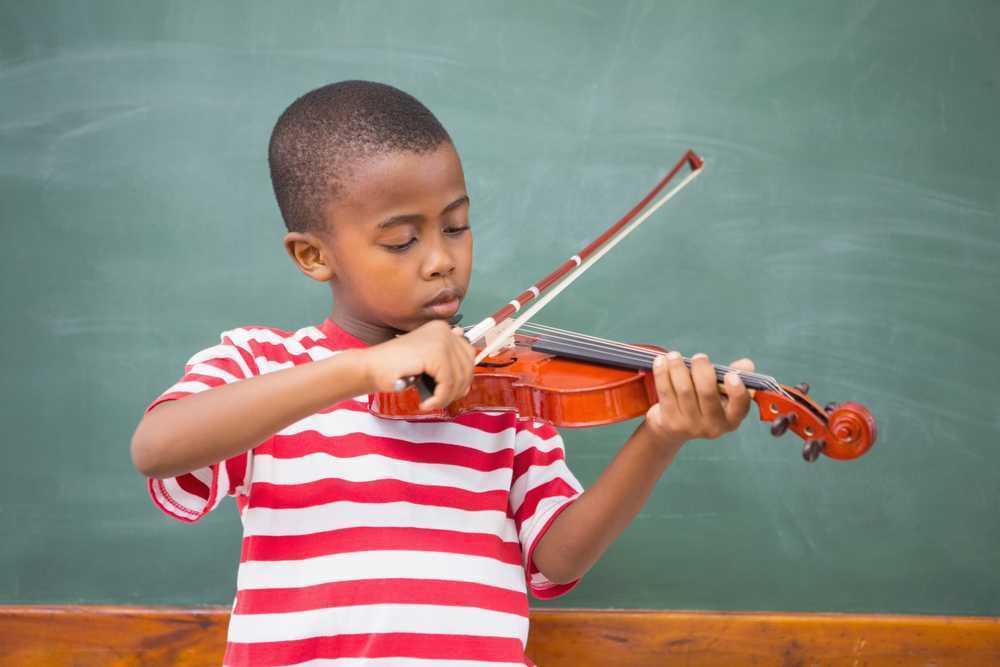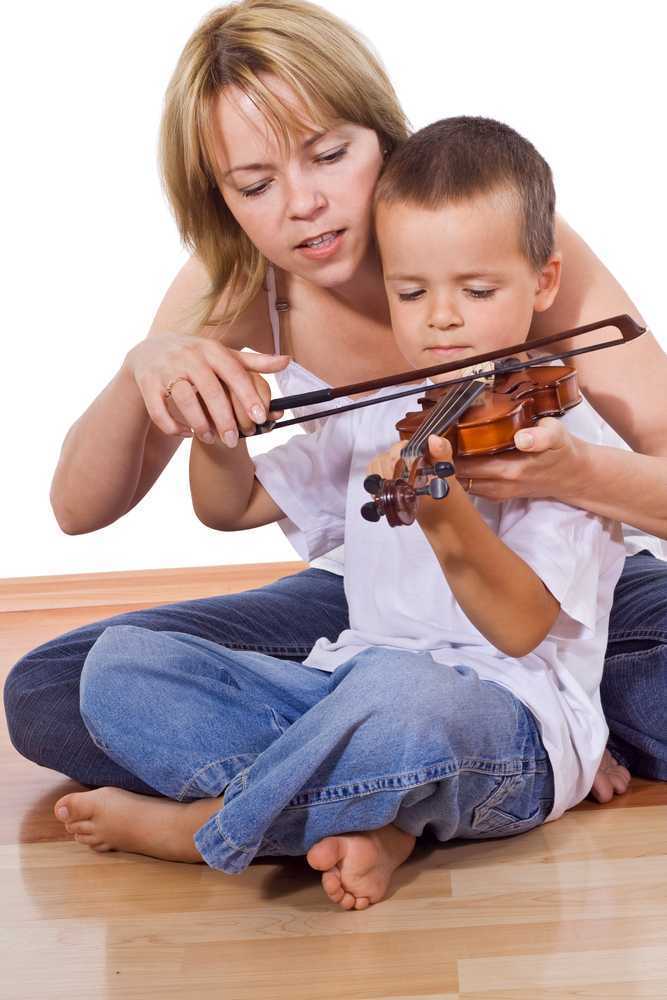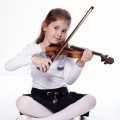When children begin to learn to play an instrument through the Suzuki method, performance is pretty much a guaranteed part of the program. Whether it’s showing Mom a new technique in the lesson or doing a different skill before a group class, a Suzuki performance is a natural part of learning, and the concept of ‘performing’ is no big deal when the child is ready to play.
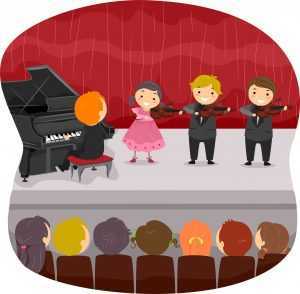
How Is Performance Presented in the Suzuki Method?
In traditional Suzuki lessons, the teacher, student, and parent are a tight-knit group. They work as a team, rather like how a sports coach works closely with the athlete and her family. There is plenty of one-on-one between the student and teacher, but the parent is expected to help when the teacher is not there – for example, during home practice sessions.
The beauty of this system is that the child is used to having observers close by at all times. Will there ever be a time when the child works on his music without supervision? Certainly, especially as the child grows and matures. But when it is ‘normal’ to have a group around you as you play, especially when the child is young, this is the first step in preparing the student for performance proficiency.
Traditional Suzuki Performance Opportunities: Small Groups
Depending on the Suzuki teacher and program you attend, there will usually (but not always) be opportunities to work in group classes. A group class is composed of students at approximately the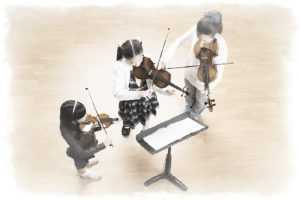 same skill level. They are usually grouped by book level, so everyone generally knows the same pieces. In a group class, there will be peers and parents there, along with the teacher. Playing in an ensemble is normal – everybody wants to play, so they learn to play as a group. The teacher may have different activities to encourage dynamics, rhythm, working in sync, you name it – but there should be a purpose to the activities that are done in class.
same skill level. They are usually grouped by book level, so everyone generally knows the same pieces. In a group class, there will be peers and parents there, along with the teacher. Playing in an ensemble is normal – everybody wants to play, so they learn to play as a group. The teacher may have different activities to encourage dynamics, rhythm, working in sync, you name it – but there should be a purpose to the activities that are done in class.
Peer Group Performances
During a group class, students may be called upon to demonstrate skills or techniques. Sometimes this happens in small groups – say the class is divided in half and the two sides try to ‘play that tune’ as the teacher calls out the name of a Suzuki piece. Or maybe, the students play centipede style – the kid first in line does the first two notes of Perpetual Motion (a favorite Book 1 piece), the next one plays the next two notes, the next takes the next two, and so on until they get to the end of the piece. Is this solo playing? Yes. But it is solo practice in the comfortable setting of keeping on your toes and keeping the game going. Are the parents watching, like an audience? Sure. But why worry about it? Having Mom and Dad positively supporting you is always welcome. When the child is involved in music making, he is developing a terrific level of concentration and confidence in his skills.
Suzuki Group Concerts
Now, lessons and group class are great ‘starter’ places to begin your Suzuki performance training. But in the Suzuki method, there is also a frequent series of concerts that children look forward to. Sometimes, it’s a ‘play-in’ or ‘play-down.’ In these events, all the students from the program are gathered on a stage (or the front of a church, or an auditorium – whatever venue your program uses). Then, they start with one song that some children know (led by the teacher and perhaps a piano accompanist) as the parents watch from the seats. The next song is known by a few more children, so they stand and play along. This continues until all the kids are standing and playing, usually on the simplest of the Suzuki repertoire for the newest players.
This is a fantastic way to keep things fun. The child sees a familiar teacher leading the music, she has classmates who are playing right next to her, and her parents are out in the audience, close enough for comfort (and primed with the video recorder, so she can watch it later, if she wants). The applause is a neat bonus – and the signal for the kids to head for their parents and the snacks afterwards! (Yes, having a carry-in snack or treat at the end is sometimes the real goal, for some kids. Go ahead and let it be that way – it makes the whole performing experience a good one.)
Suzuki Solo Recitals
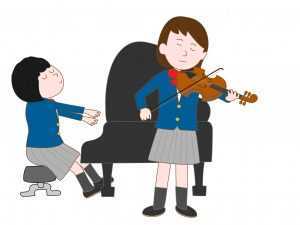 Then, there are solo recitals. Some programs simply have a series of concerts where the students get up to play their polished tune as a solo with a piano accompanist before a group of fellow students and parents. Other programs like to do ‘graduation recitals,’ which were designed by music education founder Dr. Shinichi Suzuki to serve as stepping stones of progress. You graduate from one level of playing to the next and your solo with the pianist is proof that you have achieved proficiency in the repertoire.
Then, there are solo recitals. Some programs simply have a series of concerts where the students get up to play their polished tune as a solo with a piano accompanist before a group of fellow students and parents. Other programs like to do ‘graduation recitals,’ which were designed by music education founder Dr. Shinichi Suzuki to serve as stepping stones of progress. You graduate from one level of playing to the next and your solo with the pianist is proof that you have achieved proficiency in the repertoire.
Some programs have both a solo recital and a graduation recital. Either way, it is a more formal event when kids get to dress up and have a reception at the end. It is great ensemble work, too, to be playing with an accompanist (some programs let you have several rehearsals with the pianist before the recital).
And one last Suzuki performance venue kids usually have is the book concert. When a student has mastered all the pieces in a Suzuki book, he usually gives a little solo recital of all the music. This can be done just before a few friends, maybe the grandparents and close relatives, or before a church group or retirement center crowd. Seriously, when children play music at a retirement center, the benefit is multiplied: the elderly appreciate the change in scenery, your child gets great experience playing in a new place, and he is able to interact with many different ages of people.
Practicing Performance = Comfort with Being Front and Center
When a child has been through the Suzuki performance system of preparation, he is comfortable with the concept of an audience. Play in front of peers? No problem. Play with an accompanist? Been there, done that. Perform before an audition committee – maybe only three people there? That is old hat. The child has been through many different experiences that have given him performance proficiency. Performing is a natural part of living the musical life, and it isn’t a concept to worry about.
Developing Concentration
Developing concentration is a side benefit to Suzuki performing. When a child is used to reviewing old pieces and memorizing music, it helps him or her prepare for musical excellence. Suzuki  students are typically not taught with the music in front of them. The parents can use the music, the teacher uses the music, but the student does not. He or she learns by ear and by example from the teacher or fellow classmates. The teacher will sometimes refer to the music, as in “See, that’s an up bow” or “These crescendos need to be louder” but especially for young children, the sheet music is just a peripheral. This helps the child develop musical independence. If you can hear it in your ear as you play it, you can keep on playing even when someone else becomes distracting, whether it is the piano accompanist struggling with a page turn or someone in the audience who has a coughing fit.
students are typically not taught with the music in front of them. The parents can use the music, the teacher uses the music, but the student does not. He or she learns by ear and by example from the teacher or fellow classmates. The teacher will sometimes refer to the music, as in “See, that’s an up bow” or “These crescendos need to be louder” but especially for young children, the sheet music is just a peripheral. This helps the child develop musical independence. If you can hear it in your ear as you play it, you can keep on playing even when someone else becomes distracting, whether it is the piano accompanist struggling with a page turn or someone in the audience who has a coughing fit.
To help encourage students to keep concentrating on their own playing instead of the playing of others, some Suzuki students are instructed to ‘watch your highway.’ This means that you’re looking at the general area of the violin strings between the bridge and the fingerboard, right where the bow connects with the string. Sometimes called the “Kreisler Highway,” it means that you watch the ‘highway’ of your violin, to keep your bow straight. (Fritz Kreisler, the virtuoso violinist, was the inspiration of the name, by the way. Kreisler sounds like Chrysler, which blends with the idea of cars, hence the ‘highway’ concept.)
[su_box title=”Tip: ” box_color=”#6a1db0″ title_color=”#fefefe” radius=”0″ class=”width: 200px;height: 400px;”]If a child has difficulty looking at a point on the violin which is that close to his face, the teacher will sometimes choose a different spot on the instrument to become the focus point. The student watches the new spot and the same goal is accomplished.[/su_box]
Keeping your eyes on the Kreisler highway helps keep your bow from yawing sideways on the strings. It also keeps you from being distracted by the puppy trotting into the room, or a sibling using Legos in the corner of the teacher’s studio.
Other tips your teacher may give you for a good Suzuki performance are along the lines of ‘practice until you can’t mess up.’ Will you get to do a dry run of your performance? Ask the teacher. If she doesn’t tell you this ahead of time, then you can ask: how do I approach the stage? When should I bow? How many times? May I tune before I play? Will I be able to acknowledge the accompanist? Which way do I leave the stage?
The most successful Suzuki students put in a goodly amount of elbow grease during their practice sessions. This means that they memorize the music, and their stage moves, then practice them until they are second nature.
Final Performance Tips to Keep in Mind for the Suzuki Player
- Practice until you can’t forget it. Okay, so you know your child knows the song. But can he keep playing when something else happens – like a door slamming? College music professors train students to concentrate for a recital by wandering around the auditorium and making noises, like dropping books or flipping seats as the student plays from the stage. When the college student is immune to jumping at a dropped binder, she is ready to perform. When your child has practiced so much that moderate ambulatory noise doesn’t faze her, then you’re good to go.
- Remember, your child is aiming for his or her personal best – not to beat the other kids. You know how hard your child has worked! So keep the pressure off. Just enjoy the moment and let your child shine. The calmer you are, the calmer your child will be and the better your overall experience will be. Celebrate the accomplishment of having completed a performance. Your child did her best – and you appreciate that.
- Kids start to freak out when someone asks them how nervous or scared they are. This is true for musicians (or performers of any type). Instead of asking about the negatives, project the positives. Children pick up security from their parents and teachers. Let them know you’re on their side, and that you expect them to do well. You’ve seen them do it before, and they are capable of doing it again. Treat the performance as something natural, because it is. Getting up in front of an audience is something some people do every day; think of people who do lots of work in front of a crowd, like teachers, preachers, and athletes. Having an audience doesn’t hold them back, so it’s nothing to worry about for you.
- Practice slow breathing, calm conversation, and light stretches. It’s a good idea to do some warming up before your child begins playing in any situation. So get into the habit of warming up all the time. Then, it’s a natural calm-down technique any time he or she gets ready to play – not just when a Suzuki performance is about to occur.
- Finally, keep this in mind: mistakes happen. They may seem huge to the musician as he or she is playing, but most other people don’t even notice that ‘big’ goof on the grace note or the desperate squawk in a shift.
Conclusion

Phones ring, pagers beep, and circuit breakers blow out lights. There’s nothing new under the sun, even if it is new to your child. Musicians, just like workers in any other field, pick up where they left off and keep on playing. Maybe it’s better to start over – go ahead. But don’t dwell on mistakes.
Just say, “Okay, it happened and I’ll know what to expect the next time.” Of course, if there is a real emergency, don’t just play through it. Stop, figure out what to do, and stay safe.
But for other issues that come up, like a surprise cell phone rock anthem or a total mind blank, stay calm. You will survive. It’s natural to have a glitch every so often, and it’s all part of the Suzuki performance learning experience. You are part of a Suzuki team. You are prepared for performance, and you know what to do.

